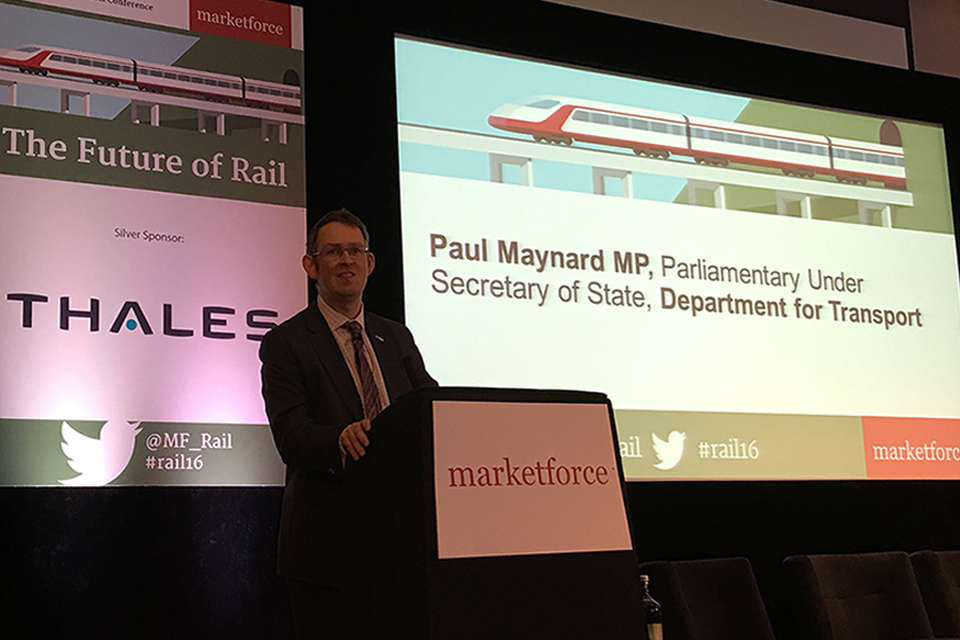Putting passengers first
Rail Minister鈥檚 vision for the future.

Introduction
The Future of Rail 鈥� is it Elon Musk鈥檚 Hyperloop? I remember watching Tomorrow鈥檚 World as a child. Is it personal drones, flying Segways, levitation, air-powered bicycles?
My vision is somewhat more radical than that. I want to see passengers receiving exemplary customer service from the moment they decide to make a journey.
I want to see a reliable, punctual, timely train service, where the passenger has a decent chance of getting a seat.
My radical vision for our future railway is one where the passengers always come first, and are never just an inconvenient afterthought in the process of moving pieces of metal along other pieces of metal.
Is this really radical? Do you think that鈥檚 what customers get already? I am concerned that, far too often, and despite the best efforts of committed rail staff, it remains undeniable that they don鈥檛 get it, day in and day out.

How we got here
So how did we get in this position?
Recently we鈥檝e got used to celebrating what the rail industry has achieved since privatisation. And in so many areas, rightly so:
- twice as many people are using the railways than 20 years ago
- and despite ours being the oldest rail network on earth, and the most intensively-used in Europe, it has one of the best health and safety records too
- we support 200,000 jobs and pay up to 拢4 billion in tax, boosting the UK鈥檚 productivity by 拢10 billion a year.
- and it鈥檚 because people have turned to the railways in record numbers that the railways are securing record investment
- not just HS2 and Crossrail, but the improvements to our existing track and trains, the new stations we鈥檙e building and the old ones we鈥檙e refurbishing 鈥� not least London Bridge which I passed on the way here
This is all superb news 鈥� and worth celebrating.
But we must never let the sound of celebration deafen us to what customers are saying.
And those who listen to the underlying drumbeat of customer sentiment on the platform will find that customers are not universally congratulating the industry on a railway that gets better and better.
They鈥檙e not expressing their growing satisfaction with the punctuality and comfort of their trains.
Overall customer satisfaction is now back to where we were a decade ago.
And my view on these things is that, as usual, the customer is always right.
There has been a year-on-year decline in train punctuality and performance for the past 5 years.
Trains are crowded already 鈥� and getting more so.
The railway remains expensive to run.
And all this is having consequences. Trust in rail providers, as various surveys show, is far too low, especially compared to comparable services.
Yet I am also acutely aware that the industry is facing pressures beyond its immediate control.
The rise in passengers, for example, is a good thing 鈥� be in no doubt 鈥� but sometimes it feels as if the industry is a victim of its own success. But that doesn鈥檛 mean the challenge is going away.
So I am clear, too, that the industry is having to deal with a long legacy of underinvestment left by successive governments.
For periods both before and after privatisation, our railways didn鈥檛 always receive the cash needed to keep them in good order 鈥� let alone to keep pace with growing demand.
Now we鈥檙e paying the price, by trying to squeeze that investment into as short a space of time as possible. In some cases, that investment has been much more difficult to deliver than was anticipated. And in others, the investment has led to even more disruption for passengers in the short term that I鈥檓 sure we鈥檙e all aware of.
We are putting these things right. We鈥檙e putting more cash into rail than any government has done for a century or more. But even taking into account that this investment is long overdue, there are areas where the industry can do better.
Our mission must be nothing less than to win back the public鈥檚 affection for the railway.
I believe that to be achievable.
In this country, we tend to be proud of our railways 鈥� and rightly so. I don鈥檛 believe that traditional affection has gone away. Yet the journey to bring it back won鈥檛 be easy. And it鈥檚 a journey we must take together.
Public affection for the railways should not be reliant upon an aching nostalgia for the days of yore when your face was covered in smut as you leaned out of the window. Public affection needs to equally stem from the quality of the service passengers receive today, their enthusiasm for modern, up-to-date rolling stock, and their confidence in the value of the fares they are paying.
Every rail minister wants to put passengers first. You wouldn鈥檛 last long in the job if you didn鈥檛. One of my very first actions as rail minister was to meet with the Rail Delivery Group and level them with a steely, if not a little petrified, gaze that I was there to put passenger interest first, and that would be my sole test of every idea they brought to me, rather than the convenience of the industry. 鈥楶assenger first鈥� was my mantra.
And it鈥檚 also the sole test of every policy decision I have taken since I got the job.
This wasn鈥檛 just words. Look at the action we鈥檝e taken so far.
We have applied the Consumer Rights Act to train operating companies.
We鈥檝e announced that passengers will soon get compensation for any train delay longer than 15 minutes.
We鈥檙e having a renewed push on smart ticketing.
We鈥檙e seeking to ensure that our wider fares and ticketing system is as modern and up-to-date as it can be in a data-driven world.
But is that enough, yet? I fear not.
Innovation
If we鈥檙e really to turn things around, and win back customer confidence, we need to look at how the industry has succeeded in delivering change in the past 鈥� and repeat that success.
21 years ago privatisation turned round what was a failing industry. 21 years ago commercial innovation in rail became possible.
Since then, we鈥檝e seen the introduction of Advance Saver Tickets, the widespread provision of real-time platform information, better train management allowing more services to run on existing tracks and, of course, significant improvements in safety.
Most of these things we now take for granted. But all of them were introduced, increased or substantially expanded following privatisation.
Yet in recent years, that pace of innovation, I think, has slowed. Why? Well, you tell me. But look at how little the rail industry spends on R&D compared to other transport industries, such as automotive and aerospace.
Even some fairly traditional sectors spend three times what the rail industry spends on R&D.
And it鈥檚 not just about money either. The way the industry is structured, including the relatively short length of franchises, does not always create the ideal incentives for investment in R&D.
And it鈥檚 also about ambition. I fear that the railway has become conservative 鈥� with a small 鈥榗鈥�, I hasten to add 鈥� so that changes common in other manufacturing and service industries are still far, far off in rail.
I fear an increasing gap opening up between what passengers want and what train operators can provide.
You might not agree with that assessment. That might not be how it feels within the rail industry where I know many people are working hard to do better for passengers. But I think our starting assumption always has to be that passengers are right to demand more from us.
The candidates for attention are obvious.
We must go further in offering automatic compensation when trains are delayed.
We must go further in offering passengers real-time location information about their trains. Information they can rely on. The kind of information that bus passengers now take for granted in so many parts of the country.
And speaking of buses, why is it now increasingly common for even rural buses to offer free WiFi, yet not on many intercity rail services?
And then there鈥檚 that perennial exasperation 鈥� ticketing. Why should we have a ticketing system which only one man on the planet, the esteemed Barry Doe of Rail magazine, actually seems to properly understand?
But I said that this is a journey that we have to go on together 鈥� not singly or in pairs.
As part of that I am looking at, from April, moving responsibility for delivery of 顿蹿罢鈥檚 investment in rail innovation to Innovate UK, the government鈥檚 innovation agency.
By making this change, we will connect the rail industry more closely with Innovate UK and the R&D ecosystem 鈥� and the opportunities that exist there. In the Autumn Statement you will have heard the Chancellor announced an additional 拢2 billion of R&D funding in this Parliament, making a total of 拢4.7 billion in total, to boost our industrial strategy and the way we innovate.
I want to see the rail sector raising its game, investing its own money and leveraging all the public support available, better to deliver for passengers.
To ensure no break in support, we will still invest 拢13.2 million with the RSSB this financial year to boost rail innovation, matched by almost 拢5 million from the private sector over the next 3 years.
And of course, the Chancellor also announced 拢450 million of new funding for digital signalling to improve the capacity and reliability on our railways 鈥� clear evidence of the government鈥檚 commitment and a great opportunity, I believe, for the industry to demonstrate how it can drive this much-needed modernisation.
This action should help. But we want to go further. So in coming days and weeks, we鈥檙e going to look at:
- how we ensure the industry is relentlessly focussed on ensuring it is acting in the best interests of passengers
- how we can attract more and more diverse sources of funding for rail
- and we鈥檙e going to look again at that ripest candidate for change: ticketing
Conclusion
I can鈥檛 go into the details just yet. In some cases the ideas are still in development. And many of them require a speech of their own. Yet, in each case, we want to work with you. We want your ideas, your proposals, your fresh ambition to put passengers first. We want you to transform this industry 鈥� just as you did 21 years ago and made it such a success.
And the opportunities are huge, to respond to and anticipate social changes, such as home working, rapid advances in telecommunications, and the digital railway.
If we get it right, we鈥檒l have a railway that people are proud to travel on, proud to have in this country and a railway that we鈥檙e all proud to lead. Thank you for listening and thank you for joining me on this journey to a better railway of the future.